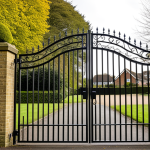Creating real estate developments that are both economically viable and environmentally sustainable has become a global challenge. The construction industry’s environmental footprint is massive, and with the rising demand for housing and commercial spaces, it becomes imperative to come up with strategies that consider economic practicality and environmental concerns. As a developer, investor, architect, or any stakeholder, you need to consider blending these two aspects for a balanced outcome. This article explores several strategies that can be adopted to achieve this crucial balance.
1. Incorporating Green Building Practices
The introduction of green building practices is one of the most significant strategies in achieving environmentally sustainable and economically viable real estate developments. Green building refers to both a structure and the application of processes that are environmentally responsible and resource-efficient throughout a building’s life-cycle.
Also to see : How to leverage digital platforms and social media for effective marketing of real estate projects?
When you opt for green building practices, you integrate elements that lower energy usage, reduce waste, and minimize the negative impact your project has on the environment. This could involve using energy-efficient materials, incorporating renewable energy systems, and optimizing water usage.
While implementing these methods may cost more upfront, they often result in significant long-term savings. For instance, installing solar panels can reduce reliance on grid electricity, resulting in lower energy costs over time. Similarly, the use of high-quality insulation can minimize heating and cooling costs, while water-efficient fixtures can lower water bills.
Also to read : What innovative solutions can be employed to ensure the resilience of real estate assets to climate-related risks?
2. Promoting Density and Urban Infill
Promoting density, or urban infill, refers to the development of vacant or under-used parcels within existing urban areas that are already largely developed. This strategy can play a crucial role in creating sustainable and economically viable real estate developments.
By focusing on urban infill, you can make use of existing infrastructure, such as roads, schools, and utilities, instead of building new ones. This not only reduces the financial burden associated with new infrastructure but also helps to preserve natural habitats and agricultural land outside urban areas.
Moreover, higher-density developments can be more energy-efficient than sprawling suburban developments. They often encourage walking, cycling, or public transportation use, reducing the dependency on private vehicles and hence lowering greenhouse gas emissions.
3. Prioritizing Affordable Housing
Affordable housing is a key factor in economically viable and environmentally sustainable real estate developments. Creating affordable housing in areas with good access to public transportation, jobs, and essential services can reduce commuting distances and the associated greenhouse gas emissions.
Additionally, affordable housing often incorporates energy-efficient design principles, such as good insulation and efficient heating and cooling systems. These features not only reduce the environmental impact of the buildings but also lower the cost of living for residents.
By creating affordable housing, you can contribute to social equity and inclusivity, which are key aspects of sustainable development. You also cater to a broader market segment, enhancing the financial viability of your projects.
4. Implementing Life-Cycle Assessment
Life-cycle assessment (LCA) is a method used to evaluate the environmental impacts of different stages in a product’s life, from raw material acquisition through production, use, and disposal. In the context of real estate development, LCA can be a valuable tool in creating sustainable and economically viable projects.
By conducting an LCA, you can understand the environmental footprint of different design and construction choices. This can guide you to select materials and techniques that minimize environmental impacts and potentially save costs in the long run. For instance, choosing locally sourced, sustainable materials can reduce transportation costs and emissions, while also supporting local economies.
5. Embracing Technology and Innovation
The use of technology and innovation in design and construction processes can significantly contribute to environmentally sustainable and economically viable real estate developments.
Technology can help in creating smart buildings that optimize energy use, reduce waste, and improve overall operational efficiency. For instance, Building Information Modeling (BIM) can aid in designing efficient buildings by providing detailed insights into building performance before construction begins. It can also speed up construction processes, reducing labor costs.
Innovations in construction materials can also contribute to sustainability. For example, the use of cross-laminated timber (CLT), a sustainable and strong material, can reduce the need for concrete and steel, which have high carbon footprints.
In summary, achieving environmentally sustainable and economically viable real estate developments requires a multifaceted approach that incorporates green building practices, promotes urban density, prioritizes affordable housing, implements life-cycle assessments, and embraces technology and innovation. By adopting these strategies, you can contribute to a more sustainable future while ensuring the economic success of your projects. Remember, sustainability and profitability are not mutually exclusive, but rather complementary components of successful real estate development.
6. Encouraging Sustainable Urban Planning
When it comes to real estate development, sustainable urban planning should be a core strategy. This involves planning and designing urban environments that are economical, sociocultural, and environmentally friendly.
Sustainable urban planning aims to minimize the need for new land, energy, and other resources by promoting density and mixed-use developments. By creating compact, walkable communities, developers can reduce the reliance on private vehicles, thereby reducing carbon emissions and energy consumption.
In addition, sustainable urban planning also involves the preservation of local ecosystems and the integration of green spaces into urban areas. This not only contributes to the overall environmental sustainability but also enhances the quality of life for the residents, making the development more appealing and, consequently, more economically viable.
Moreover, sustainable urban planning fosters a sense of community and encourages social interaction, which can have a positive impact on the economic success of a development in the long term. By creating spaces where people want to live, work, and play, developers can ensure the longevity and success of their projects.
7. Deploying Renewable Energy Systems
Another effective strategy for creating environmentally sustainable and economically viable real estate developments is the deployment of renewable energy systems. These can include solar panels, wind turbines, and geothermal heat pumps, which not only reduce a building’s environmental impact but can also result in significant long-term savings.
Investing in renewable energy systems can lower energy costs and offer a level of protection against future energy price increases. Moreover, it can enhance the appeal of the property for prospective buyers or tenants who prioritize environmental sustainability, thereby contributing to the economic viability of the project.
In some cases, renewable energy systems can even generate excess power that can be fed back into the grid, resulting in an income stream for the property owner. Furthermore, several governments offer incentives for the implementation of renewable energy systems, such as tax credits or subsidies, which can further improve the economic feasibility of such initiatives.
Conclusion: Towards Sustainable and Profitable Real Estate Development
In conclusion, achieving an optimal balance between environmental sustainability and economic viability in real estate development is not only attainable but necessary in the face of growing concerns about climate change. It requires a holistic approach that integrates a range of strategies, from green building practices and sustainable urban planning to the adoption of renewable energy systems and technology innovations.
By adopting these strategies, developers can significantly reduce their environmental footprint and mitigate the impact of climate change while ensuring the long-term profitability of their projects. After all, sustainable development is not just about being eco-friendly; it’s about working smart, reducing costs, maximizing return on investment and, ultimately, contributing to a healthier and more sustainable future for all.
As the global community continues to grapple with the challenge of sustainable development, those in the real estate sector have a significant role to play. By embracing the strategies outlined in this article, real estate developers can help lead the way towards a more sustainable and economically viable future.











